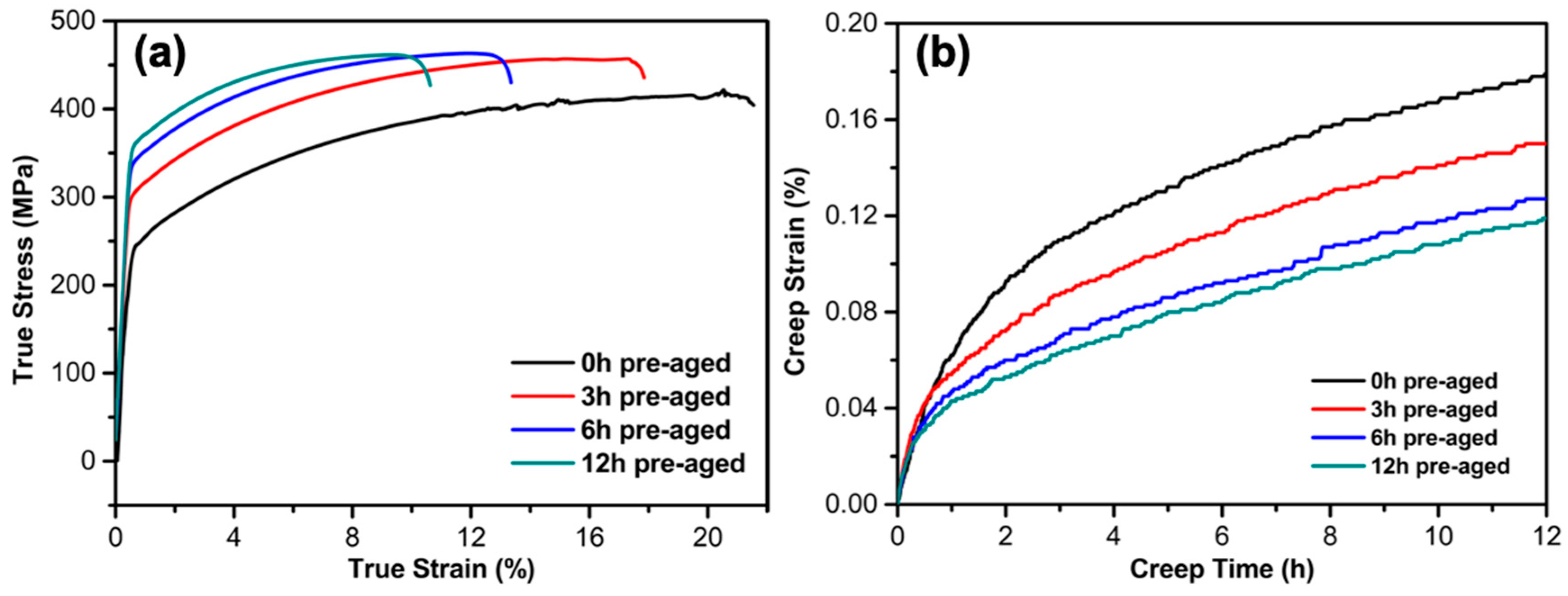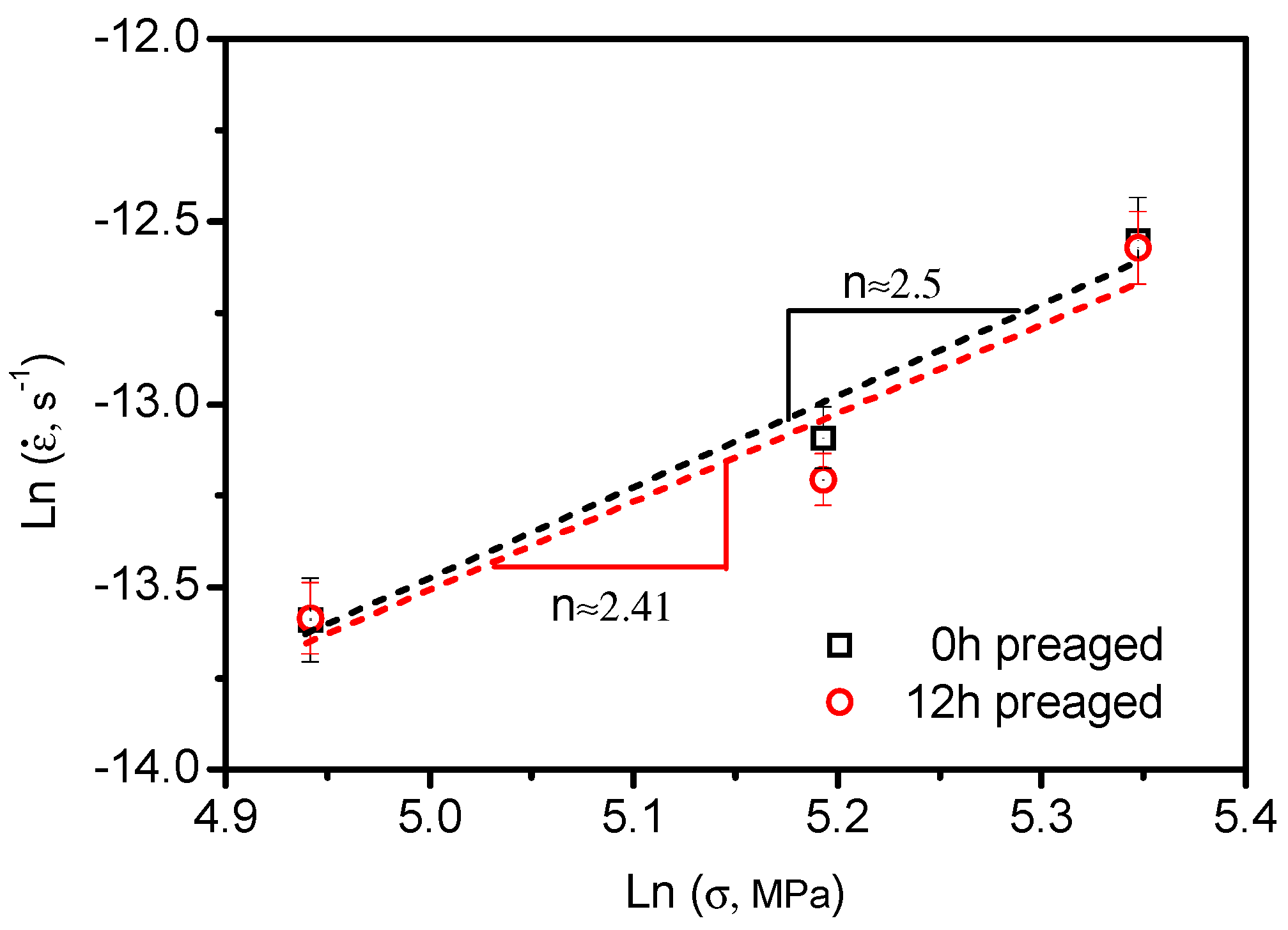Creep Mechanisms of an Al–Cu–Mg Alloy at the Macro- and Micro-Scale: Effect of the S′/S Precipitate
Abstract
:1. Introduction
2. Material and Methods
2.1. Macro-Creep Tests
2.2. Micro-Creep Tests
3. Results and Discussion
3.1. Microstructure of the Pre-Aged Al Alloy
3.2. Macro-Creep Mechanism
3.3. Micro-Creep Mechanism
4. Conclusions
Author Contributions
Funding
Conflicts of Interest
References
- Dursun, T.; Soutis, C. Recent developments in advanced aircraft aluminium alloys. Mater. Des. 2014, 56, 862–871. [Google Scholar] [CrossRef]
- Xu, Y.; Zhan, L.; Xu, L.; Huang, M. Experimental research on creep aging behavior of Al-Cu-Mg alloy with tensile and compressive stresses. Mater. Sci. Eng. A 2017, 682, 54–62. [Google Scholar] [CrossRef]
- Xu, Y.; Zhan, L.; Li, W. Effect of pre-strain on creep aging behavior of 2524 aluminum alloy. J. Alloys Compd. 2017, 691, 564–571. [Google Scholar] [CrossRef]
- Zhan, L.; Lin, J.; A Dean, T. A review of the development of creep age forming: Experimentation, modelling and applications. Int. J. Mach. Tools Manuf. 2011, 51, 1–17. [Google Scholar] [CrossRef]
- Ma, Z.; Zhan, L.; Liu, C.; Xu, L.; Xu, Y.; Ma, P.; Li, J. Stress-level-dependency and bimodal precipitation behaviors during creep ageing of Al-Cu alloy: Experiments and modeling. Int. J. Plast. 2018, 110, 183–201. [Google Scholar] [CrossRef]
- Xu, Y.; Zhan, L.; Huang, M.; Shen, R.; Ma, Z.; Xu, L.; Wang, K.; Wang, X. Deformation behavior of Al-Cu-Mg alloy during non-isothermal creep age forming process. J. Mater. Process. Technol. 2018, 255, 26–34. [Google Scholar] [CrossRef]
- Yang, Y.-L.; Zhan, L.-H.; Li, J. Constitutive modeling and springback simulation for 2524 aluminum alloy in creep age forming. Trans. Nonferrous Met. Soc. China 2015, 25, 3048–3055. [Google Scholar] [CrossRef]
- Zhan, L.-H.; Li, Y.-G.; Huang, M.-H. Effects of process parameters on mechanical properties and microstructures of creep aged 2124 aluminum alloy. Trans. Nonferrous Met. Soc. China 2014, 24, 2232–2238. [Google Scholar] [CrossRef]
- Xu, Y.; Zhan, L.; Huang, M.; Liu, C.; Wang, X. Anisotropy in creep-ageing behavior of textured Al-Cu-Mg alloy. Int. J. Light. Mater. Manuf. 2018, 1, 40–46. [Google Scholar] [CrossRef]
- Zhan, L.; Tan, S.; Yang, Y.; Huang, M.; Shen, W.; Zhao, X. A research on creep age forming of 2524 aluminum alloy: Springback, mechanical properties and microstructures. Adv. Mech. Eng. 2014, 6, 1–8. [Google Scholar] [CrossRef]
- Maximov, J.T.; Duncheva, G.V.; Anchev, A.P.; Ichkova, M.D. Modeling of strain hardening and creep behaviour of 2024T3 aluminium alloy at room and high temperatures. Comp. Mater. Sci. 2014, 83, 381–393. [Google Scholar] [CrossRef]
- Chen, J.; Chen, Z.; Guo, X.; Deng, Y. Changing distribution and geometry of S′ in Al–Cu–Mg single crystals during stress aging by controlling the loading orientation. Mater. Sci. Eng. A 2016, 650, 154–160. [Google Scholar] [CrossRef]
- Yang, L.; Wang, C.; Monclús, M.; Lu, L.; Molina-Aldareguía, J.M.; Llorca, J. Influence of temperature on the strain rate sensitivity and deformation mechanisms of nano-twinned Cu. Scr. Mater. 2018, 154, 54–59. [Google Scholar] [CrossRef]
- Sun, W.; Jiang, Y.; Sun, G.; Hu, J.; Zhou, T.; Jiang, Z.; Lian, J. Indentation creep behavior and its relation to activation volume and strain rate sensitivity of nanocrystalline Cu. Mater. Sci. Eng. A 2019, 751, 35–41. [Google Scholar] [CrossRef]
- Liu, X.; Zhang, Q.; Zhao, X.; Yang, X.; Luo, L. Ambient-temperature indentation creep in ultrafine-grained titanium processed by ECAP. Mater. Sci. Eng. A 2016, 676, 73–79. [Google Scholar] [CrossRef]
- Hong, Y.; Zhou, C.; Zheng, Y.; Zhang, L.; Zheng, J.; Chen, X. Effect of hydrogen and strain rate on indentation creep of austenitic stainless steel. Int. J. Hydrogen Energy 2019, 44, 1253–1262. [Google Scholar] [CrossRef]
- Maier, V.; Durst, K.; Mueller, J.; Backes, B.; Happel, H.W.; GeKen, M. Indentation strain-rate jump tests for determining the local strain-rate sensitivity in nanocrystalline Ni and ultrafine-grained Al. J. Mater. Res. 2011, 26, 1421–1430. [Google Scholar] [CrossRef]
- Sambhava, K.; Nautiyal, P.; Jain, J. Model based phenomenological and experimental investigation of indentation creep in pure Mg and AZ61 alloy. Mater. Des. 2016, 105, 142–151. [Google Scholar] [CrossRef]
- Wang, C.; Liao, Y.; Chu, J.P.; Hsueh, C. Viscous flow and viscosity measurement of low-temperature imprintable Au-Cu-Si thin film metallic glasses investigated by indentation creep. Mater. Des. 2017, 123, 112–119. [Google Scholar] [CrossRef]
- Koch, S.; Abad, M.D.; Renhart, S.; Antrekowitsch, H.; Hosemann, P. A high temperature indentation study of Al–Cu wrought alloy. Mater. Sci. Eng. A 2015, 644, 218–224. [Google Scholar] [CrossRef]
- Böhner, A.; Maier, V.; Durst, K.; Höppel, H.W.; Göken, M. Macro- and nanomechanical properties and strain-rate sensitivity of accumulative roll bonded and equal channel angular pressed ultrafine-grained materials. Adv. Eng. Mater. 2011, 13, 251–255. [Google Scholar] [CrossRef]
- Lei, C.; Li, H.; Fu, J.; Bian, T.J.; Zheng, G.W. Non-isothermal creep aging behaviors of an Al-Zn-Mg-Cu alloy. Mater. Charact. 2018, 144, 431–439. [Google Scholar] [CrossRef]
- Shen, F.; Wang, B.; Liu, H.; Jiang, Y.; Tang, C.; Shou, W.; Pan, S.; Chen, Y.; Yi, D. Effects of secondary particle-induced recrystallization on fatigue crack growth in AA2524/Al-Cu-Mg T3 alloy sheets. J. Alloys Compd. 2016, 685, 571–580. [Google Scholar] [CrossRef]
- Xu, Y.; Zhan, L.; Ma, Z.; Huang, M.; Wang, K.; Sun, Z. Effect of heating rate on creep aging behavior of Al-Cu-Mg alloy. Mater. Sci. Eng. A 2017, 688, 488–497. [Google Scholar] [CrossRef]
- Lin, Y.; Xia, Y.; Jiang, Y.; Li, L. Precipitation in Al-Cu-Mg alloy during creep exposure. Mater. Sci. Eng. A 2012, 556, 796–800. [Google Scholar] [CrossRef]
- Wang, S.; Starink, M.J. Two types of S phase precipitates in Al-Cu-Mg alloys. Acta. Mater. 2007, 55, 933–941. [Google Scholar] [CrossRef]
- Li, Y.; Shi, Z.; Lin, J.; Yang, Y.; Rong, Q.; Huang, B.; Chung, T.; Tsao, C.; Yang, J.; Balint, D.S. A unified constitutive model for asymmetric tension and compression creep-ageing behaviour of naturally aged Al-Cu-Li alloy. Int. J. Plast. 2017, 89, 130–149. [Google Scholar] [CrossRef] [Green Version]
- Mohebbi, M.S.; Akbarzadeh, A. Development of equations for strain rate sensitivity of UFG aluminum as a function of strain rate. Int. J. Plast. 2017, 90, 167–176. [Google Scholar] [CrossRef]
- Varam, S.; Rajulapati, K.V.; Rao, K.B.S. Strain rate sensitivity studies on bulk nanocrystalline aluminium by indentation. J. Alloys Compd. 2014, 585, 795–799. [Google Scholar] [CrossRef]
- Maier, V.; Merle, B.; Göken, M.; Durst, K. An improved long-term indentation creep testing approach for studying the local deformation processes in nanocrystalline metals at room and elevated temperatures. J. Mater. Res. 2013, 28, 1177–1188. [Google Scholar] [CrossRef]
- Wheeler, J.M.; Maier, V.; Durst, K.; Goken, M.; Michler, J. Activation parameters for deformation of ultrafine-grained aluminium as determined by indentation strain rate jumps at elevated temperature. Mater. Sci. Eng. A 2013, 585, 108–113. [Google Scholar] [CrossRef]
- Chinh, N.Q.; Csanádi, T.; Győri, T.; Valiev, R.Z.; Straumal, B.B.; Kawasaki, M.; Langdon, T.G. Strain rate sensitivity studies in an ultrafine-grained Al–30 wt% Zn alloy using micro- and indentation. Mater. Sci. Eng. A 2012, 543, 117–120. [Google Scholar] [CrossRef]
- Khan, A.S.; Liu, H. Variable strain rate sensitivity in an aluminum alloy: Response and constitutive modeling. Int. J. Plast. 2012, 36, 1–14. [Google Scholar] [CrossRef]
- Ma, K.; Wen, H.; Hu, T.; Topping, T.D.; Isheim, D.; Seidman, D.N.; Lavernia, E.J.; Schoenung, J.M. Mechanical behavior and strengthening mechanisms in ultrafine grain precipitation-strengthened aluminum alloy. Acta Mater. 2014, 62, 141–151. [Google Scholar] [CrossRef]
- Gianola, D.S.; Warner, D.H.; Molinari, J.F.; Hemker, K.J. Increased strain rate sensitivity due to stress-coupled grain growth in nanocrystalline Al. Scr. Mater. 2006, 55, 649–652. [Google Scholar] [CrossRef]









| Zn | Mg | Cu | Mn | Si | Fe | Ti | Cr | Al |
|---|---|---|---|---|---|---|---|---|
| 0.01 | 1.38 | 4.4 | 0.66 | 0.03 | 0.05 | 0.03 | 0.01 | Bal. |
| Pre-Aging | Yield Strength/MPa | Tensile Strength/MPa | Elongation/% | Ultimate Creep Strain | Steady State Creep Rate (s−1) |
|---|---|---|---|---|---|
| 0 h | 265 | 403 | 22.18 | 0.00179 | 1.98 × 10−6 |
| 3 h | 291 | 435 | 17.85 | 0.0015 | 1.91 × 10−6 |
| 6 h | 303 | 440 | 13.64 | 0.00127 | 1.97 × 10−6 |
| 12 h | 331 | 439 | 10.28 | 0.00119 | 1.88 × 10−6 |
| Pre-Aged | m | V*(b3) |
|---|---|---|
| 0 h | 0.0186 ± 0.0021 | 27.50 ± 0.94 |
| 3 h | 0.0182 ± 0.0009 | 26.67 ± 0.52 |
| 6 h | 0.0169 ± 0.0018 | 28.18 ± 1.01 |
| 12 h | 0.0171 ± 0.0016 | 27.08 ± 0.98 |
| AVERAGE ± STDEV | 0.0177 ± 0.0008 | 27.36 ± 0.64 |
© 2019 by the authors. Licensee MDPI, Basel, Switzerland. This article is an open access article distributed under the terms and conditions of the Creative Commons Attribution (CC BY) license (http://creativecommons.org/licenses/by/4.0/).
Share and Cite
Xu, Y.; Yang, L.; Zhan, L.; Yu, H.; Huang, M. Creep Mechanisms of an Al–Cu–Mg Alloy at the Macro- and Micro-Scale: Effect of the S′/S Precipitate. Materials 2019, 12, 2907. https://doi.org/10.3390/ma12182907
Xu Y, Yang L, Zhan L, Yu H, Huang M. Creep Mechanisms of an Al–Cu–Mg Alloy at the Macro- and Micro-Scale: Effect of the S′/S Precipitate. Materials. 2019; 12(18):2907. https://doi.org/10.3390/ma12182907
Chicago/Turabian StyleXu, Yongqian, Lingwei Yang, Lihua Zhan, Hailiang Yu, and Minghui Huang. 2019. "Creep Mechanisms of an Al–Cu–Mg Alloy at the Macro- and Micro-Scale: Effect of the S′/S Precipitate" Materials 12, no. 18: 2907. https://doi.org/10.3390/ma12182907
APA StyleXu, Y., Yang, L., Zhan, L., Yu, H., & Huang, M. (2019). Creep Mechanisms of an Al–Cu–Mg Alloy at the Macro- and Micro-Scale: Effect of the S′/S Precipitate. Materials, 12(18), 2907. https://doi.org/10.3390/ma12182907







